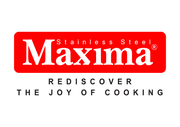Glossary Of Cooking Terms
Tri-ply kadai – Where triply means 3 layered. Top layer 18/10 food graded stainless steel middle layer almunium and 3 rd layer of 430 stainless steel magnetic which makes it induction compatible.
18/10 Stainless Steel - The steel material contains 18% chromium and 10% nickel. Chromium increases corrosion resistance and nickel adds hardness and shine. It is considered the finest quality stainless steel since it is durable, shiny and scratch-resistant. 18/8 is 18% chromium and 8% nickel.
304 Stainless Steel – 304 SS is a T 300 Series Stainless Steel austenitic, which is very corrosion resistant. It has a minimum of 18% chromium and 8% nickel, combined with a maximum of 0.08% carbon. Grade 304 is the standard "18/8" stainless that you will probably see in the cookware industry.
430 Stainless Steel – 430 SS is a non-hardenable steel containing straight chromium, and belongs to the ferritic group of steels. This steel is known for its good corrosion resistance and formability, coupled with practical mechanical properties. It can be used in certain chemical applications due to its resistance to nitric acid.
Aluminium - A light malleable ductile silvery-white metallic element that resists corrosion; a chemical element that is a light, silver-coloured metal, used especially for making cooking equipment and aircraft parts.
Hexagon Pattern / Honeycomb Structure Kadai – A honeycomb structure is a design that is created on that the bottom and is of magnetic steel and is embossed (to a honeycomb pattern ) to maintain a non stick base . The honey comb pattern with raised structure makes the non-stick layer intact for longer period. It has extreme scratch resistance hence it is safe to use with metal spoons. The magnetic steel layer in the kadai will have a small portion of the bottom surface flattened to make it induction friendly.
Anodized - The process of depositing electrolytes onto metal (most often aluminium), creating a surface coating. Anodizing seals the surface and makes the aluminium neutral (non-reactive) to foods and makes it resistant to corrosion, while retaining the excellent heat-conductive properties of aluminium.
Ceramic Cookware - Ceramic cookware is made solely from clay and a base of durable metal and finished with a coating of glazed, kiln-baked clay. The ceramic coating makes these types of pots and pans naturally non-stick, non-toxic, and easy to clean.
Kiln - A type of large oven box in which things are cooked or heated used for making bricks and clay objects become hard after they have been shaped.
Cast Iron - A hard brittle alloy of iron, carbon, and silicon shaped by being poured into a mould while melted/Its a type of hard iron that will not bend easily and is made into shapes by being poured into a mould when melted.
Corrosion Resistant - Corrosion resistance is defined as the inherent ability of a material (metallic or non-metallic) to withstand corrosion damage caused by either oxidation or other chemical reactions.
Colorfast Finish - A silicone polyester coating which resists fading and discoloring over time.
Cladding - Cladding is the application of one material over another to provide a skin or layer. Its the outer covering layer.
Colander - A colander is a kitchen utensil used to strain foods such as pasta or to rinse vegetables / A colander is a hemispherical kitchen utensil, usually made of metal (generally Aluminium or stainless steel) or plastic, with holes in it and two handles. It is used to drain the cooking water from foods.
Caramelize - To heat food until the natural sugars inside begin to break down. It gives foods a sweet, nutty flavor and causes them to brown.
Emulsify - A process of forcefully combining two liquids that don’t naturally combine.
Deglazing - It is the process of adding a liquid like wine, vinegar, or water to the frying pan after cooking. Lightly coating food with a dry ingredient, such as flour, cornmeal, or breadcrumbs. Often, you'll dredge foods before frying.
Dredge - Forage to find your own food. People often forage for wild berries and edible mushrooms.
Hull - The outer-most covering of a fruit or a vegetable.
Marinade - A seasoned liquid is used to soak the paneer or veggies to infuse the flavors of the seasoning into the pieces. For example, while making paneer tika we soak paneer in a batter.
Marination - The process of the soaking of food in a marinade in a sealed non-metallic container.
Brine - The soaking of food in a liquid solution consisting of water, salt, sugar, and possibly herbs and spices in order to preserve, tenderize, or flavor various foods A flavoring agent that is used for pickling or tenderizing the food.
Broil - Cooking the food under direct heat by placing it closer to the heat source.
Brunoise - Dicing the food so that every diced portion measures 1/8th of its original size.
Poach - Poaching is a moist method of cooking in which food is placed in liquid which is brought to and maintained at, a temperature just under boiling point.
Nonstick Skillet - A nonstick skillet is a flat-bottomed pan that serves many purposes, including searing, frying, baking, and browning.
Scrape - Removing the batter or any other residue that’s stuck to cookware.
Sear - The process of quickly browning the surface of food by exposing it to extremely high heat.
Skewer - A long narrow stick with a pointed end is used to pierce veggies before grilling it or cooking on a high flame to quickly give it a golden-brown texture.
Tagine - A conical, earthenware, cooking pot typically used in slowly simmered recipes that lock in flavor.
Zest - It is the shaving of the outer skin of citrus obtained by grating the skin with a peeler or a grater.

